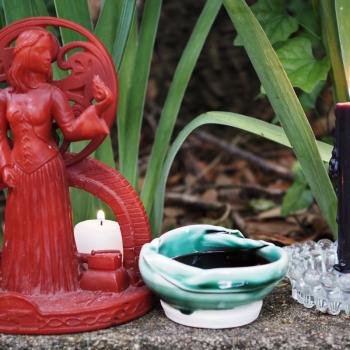
I read once that as you grow older you come to see that there is still “something to the ‘Christmas Spirit.’ Sure, perhaps there wasn’t a magic guy with a flying sleigh, etcetera, but there was an aspect of the human experience, a generosity, that we could sensibly personify as the chubby fellow in red. Santa didn’t live at the North Pole, but in the human heart.” Humans personifying a mythical role. Each becoming here, and there, an avatar of the Christmas Spirit.
To bring a spirit into your heart and to act out its will is no small thing, and it is my wish to express how very much magic is to be made in the world through this act. It is a sacred gift we give to others, often children, in taking on that role. Whether dead or alive, literal or false, or even called by another name; at the winter holidays we all, the world over, draw down a spirit – holding that magic in our own heart, and using it to better the world for another. Truly, that is the meaning of Christmas.
Pagan Parenting
I found myself at a time considering the inevitability of my children being taught about Santa Claus, with or without me, and just as inevitably, them becoming aware of the lie. Even if we celebrate the Winter Solstice and Yule as a family, Christmas is pervasive, and let’s face it, all but secular at this point. So how would my spouse and I pass the concept of Santa to our own children, while minimizing harm and finding meaning within it?
We came to prefer that they come to understand Santa Claus in the same way they already understood other Gods in our household. We Pagans are not blind to the concept of mythical beings whose physical manifestations we create as they work through us to see their will done in the world. Gods and spirits are something that we may not see, but feel, and respond to the needs of – and what is Santa Claus if not that? If we can believe in the big wonderful egregores of tradition, how then can we not believe in the thoughtform of Santa Claus, manifested by the hopes, dreams, and wishes of millions of children over one thousand, seven hundred, and fifty years? Realistically, Santa Claus has an older following than any Neo-Pagan tradition, we breathe life into him through our actions, and I would argue that it’s a real and meaningful presence.
Santa as Deity
Santa Claus is the perfect beginner’s guide to Pagan Gods, a way to have dialogue about topics that might otherwise be too complex for children to understand such as invocation, deity, myth, offerings, and libations. In addition, his rituals – writing letters, leaving milk and cookies, visiting him – are so widely known and accepted in modern culture, that the myth is easy to support. So rather than supporting an aspect of Santa that comes with an inherent falsehood (deceiving your children by teaching them to believe in a literal person who brings objects to your home), I find it useful to view the surprise aspect of gift giving on the morning of the holiday as a secret best kept for the sacred space around the tree altar.
These mysteries as passed to neophytes by the initiated (adults, older children), rather than those who are still innocent and receiving the mysteries of the holiday. We adults are in the Priesthood of the season, and it is our duty to keep sacred the mysteries of these holiday traditions until the time is right to pass them on to our little seekers of gifts. Then when the time is right, teach them what it is to hold an altar to Santa Claus in their heart, and spread that goodness to others.
Practical notes for Pagan Parents:
- Consider teaching your child that the holiday tree is an altar to the spirit of Santa, and somewhere that we place as offerings gifts that we have purchased for others in his name.
- Allow milk and cookies to become equivalent to other libations that children in your home might have seen. For example: ‘We choose certain cakes and ale because that’s what the High Priestex likes best, and they are embodying the spirit of the Goddess, what if we leave Santa eggnog and snickerdoodles since that’s what your Mommy/Daddy/Parent like best?’ Rather than leaving them out for Santa, instead enjoy them as a family, a bite for yourself, and a bite for the spirit, left in nature as we would any other libation or offering.
- Language like “That’s what the holiday spirits led me to get you!” rather than expressions like “Santa brought you a lot of neat things!” This also helps avoid situations where when returning to school, children from less affluent homes feel hurt by Santa bringing them less things than other children received. Your children will be aware that ultimately, you purchased these things on behalf of Santa.
- Allow your children to assist you in consecrating your tree skirt, treating it as a sacred circle under the tree altar in service to the spirits of the holiday, noting that the gifts underneath it are offerings to the spirit of Santa, and are surprises.
- As it is hard to separate Winter Solstice, Yule, and Christmas, I prefer to think of Christmas as Santas “feast day.”
- When visiting someone who is dressed as Santa, rather than telling your child that it is Santa, explain that it is someone who is connecting with, and embodying, the spirit of Santa. That if they tell him something they’d like Santa to hear, that the spirit of Santa will hear it.
- Consider teaching them to believe that Santa is someone you can call on to inspire goodness. “I’m going to invite/invoke Santa to help me while I pick out gifts for you!”
- Avoid the “naughty” or “nice” list language as it promotes a concept of sin. Rather, teach generosity for its own sake.
- Be certain to save fallen needles from your tree to make incense and burn for next years “yule fire!”
Tree and Tree Skirt Consecration
You’ll Need
Water
Candle
Incense
A decorated fresh cut tree
Milk and Cookies or other libation
Assist your child in lighting a candle, or using a battery operated one, preparing some incense, and in watering the tree. Then say:
By twinkling lights and candle flame,
By smoke of incense that fills the air,
By the earth in which this tree grew,
By the water that sustains it,
We make this space welcome to the spirit of giving.
Play holiday music and dance around the area to raise energy and welcome the holiday spirits into your home. Afterward, signify that the tree area is now sacred space by placing the first gifts of the season underneath as offerings to the spirits of giving. Finish by giving libation of your cookies and milk.
A Child’s “Drawing Down Santa” Ritual
Assist your child in lighting a candle, or using a battery operated one, as well as setting up an offering for Santa such as cookies and milk placed somewhere safe. Ask them to imagine Santas goodness and generosity through connecting with the holiday tree with their senses:
(For example)
Sparkling like lights (sight)
The needles of the tree (scent)
The rough bark of the trunk (touch)
Eating a candy cane hanging from it (taste)
Shaking a gift under the tree (sound)
Afterward, have your child take some action to signify that they are now embodying Santa, which could be as simple as putting on a Santa hat! Then, still in your sacred tree space, have them wrap gifts that you have chosen together in advance to gift to a charitable organization (example: Toys for Tots). Finish by giving libation of your cookies and milk, then proceed to your donation center to drop off your gift/s.

















